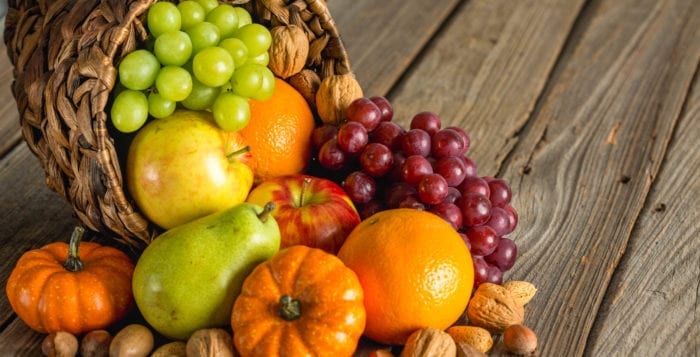By David Dunaief, M.D.

Many of us give thanks for our health on Thanksgiving. Well, let’s follow through with this theme. While eating healthy may be furthest from our minds during a holiday, it is so important. Instead of making Thanksgiving a holiday of regret, eating foods that cause weight gain and fatigue, as well as increase your risk for chronic diseases, you can reverse this trend while staying in the traditional theme of what it means to enjoy a festive meal.
What can we do to turn Thanksgiving into a bonanza of good health? Phytochemicals (plant nutrients) called carotenoids have antioxidant and anti-inflammatory activity and are found mostly in fruits and vegetables. Carotenoids make up a family of greater than 600 different substances, such as beta-carotene, alpha-carotene, lutein, zeaxanthin, lycopene and beta-cryptoxanthin (1).
Carotenoids help to prevent and potentially reverse diseases, such as breast cancer; amyotrophic lateral sclerosis, also known as Lou Gehrig’s disease; age-related macular degeneration; and cardiovascular disease — heart disease and stroke. Foods that contain these substances are orange, yellow and red vegetables and fruits and dark green leafy vegetables. Examples include sweet potato, acorn squash, summer squash, spaghetti squash, green beans, carrots, cooked pumpkin, spinach, kale, papayas, tangerines, tomatoes and Brussels sprouts.

Let’s look at the evidence.
Breast cancer effect
We know that breast cancer risk is high among women, especially on Long Island. The risk for a woman getting breast cancer is 12.4 percent in her lifetime (2). Therefore, we need to do everything within reason to reduce that risk. In a meta-analysis (a group of eight prospective or forward-looking studies), results show that women who were in the second to fifth quintile blood levels of carotenoids, such as alpha-carotene, beta-carotene and lutein and zeaxanthin, had significantly reduced risk of developing breast cancer (3). Thus, there was an inverse relationship between carotenoid levels and breast cancer risk. Even modest amounts of carotenoids potentially can have a resounding effect in preventing breast cancer.
ALS: Lou Gehrig’s disease
ALS is a disabling and feared disease. Unfortunately, there are no effective treatments for reversing it. Therefore, we need to work double-time in trying to prevent its occurrence. In a meta-analysis of five prestigious observational studies, including The Nurses’ Health Study and the Health Professionals Follow-Up Study, results showed that people with the greatest amount of carotenoids in their blood from foods such as spinach, kale and carrots had a decreased risk of developing ALS and/or delayed the onset of the disease (4). This study involved over one million people with more than 1,000 who developed ALS.
Those who were in the highest carotenoid level quintile had a 25 percent reduction in risk, compared to those in the lowest quintile. This difference was even greater for those who had high carotenoid levels and did not smoke; they achieved a 35 percent reduction. According to the authors, the beneficial effects may be due to antioxidant activity and more efficient function of the power source of the cell, the mitochondrion. This is a good way to prevent a horrible disease while improving your overall health.
Positive effects of healthy eating
Despite the knowledge that healthy eating has long-term positive effects, there are several obstacles to healthy eating. Two critical factors are presentation and perception. Presentation is glorious for traditional dishes, like turkey, gravy and stuffing with lots of butter and creamy sauces. However, vegetables are usually prepared in either an unappetizing way — steamed to the point of no return, so they cannot compete with the main course, or smothered in cheese, negating their benefits, but clearing our consciences.
Many consider Thanksgiving a time to indulge and not think about the repercussions. Plant-based foods like whole grains, leafy greens and fruits are relegated to side dishes or afterthoughts. Why is it so important to change our mind-sets? Believe it or not, there are significant short-term consequences of gorging ourselves. Not surprisingly, people tend to gain weight from Thanksgiving to New Year. This is when most gain the predominant amount of weight for the entire year.
However, people do not lose the weight they gain during this time (5). If you can fend off weight gain during the holidays, just think of the possibilities for the rest of the year. Also, if you are obese and sedentary, you may already have heart disease. Overeating at a single meal increases your risk of heart attack over the near term, according to the American Heart Association (6). However, with a little Thanksgiving planning, you can reap significant benefits.
What strategies should you employ for the best outcomes?
• Make healthy, plant-based dishes part of the main course. I am not suggesting that you forgo signature dishes, but add to tradition by making mouthwatering vegetable-based main dishes for the holiday.
• Improve the presentation of vegetable dishes. Most people don’t like grilled chicken without any seasoning. Why should vegetables be different? In my family, we make sauces for vegetables, like a peanut sauce using mostly rice vinegar and infusing a teaspoon of toasted sesame oil. Good resources for appealing dishes can be found at www.pcrm.org, EatingWell magazine, www.wholefoodsmarket.com and many other resources.
• Replace refined grains with whole grains. A study in the American Journal of Clinical Nutrition showed that replacing wheat or refined grains with whole wheat and whole grains significantly reduced central fat, or fat around the belly (7). Not only did participants lose subcutaneous fat found just below the skin but also visceral adipose tissue, the fat that lines organs and causes chronic diseases such as cancer.
• Create a healthy environment. Instead of putting out creamy dips, processed crackers and candies as snacks prior to the meal, put out whole grain brown rice crackers, baby carrots, cherry tomatoes and healthy dips like hummus and salsa. Help people choose wisely.
• Offer more healthy dessert options, like dairy-free pumpkin pudding and fruit salad. The goal should be to increase your nutrient-dense choices and decrease your empty-calorie foods. You don’t have to be perfect, but improvements during this time period have a tremendous impact — they set the tone for the new year and put you on a path to success. Why not turn this holiday into an opportunity to de-stress, rest and reverse or prevent chronic disease by consuming plenty of carotenoid-containing foods.
References: (1) Crit Rev Food Sci Nutr 2010;50(8):728–760. (2) SEER Cancer Statistics Review, 1975–2009, National Cancer Institute. (3) J Natl Cancer Inst 2012;104(24):1905-1916. (4) Ann Neurol 2013;73:236–245. (5) N Engl J Med 2000; 342:861-867. (6) www.heart.org. (7) Am J Clin Nutr 2010 Nov; 92(5):1165-1171.
Dr. Dunaief is a speaker, author and local lifestyle medicine physician focusing on the integration of medicine, nutrition, fitness and stress management. For further information, visit www.medicalcompassmd.com or consult your personal physician.






